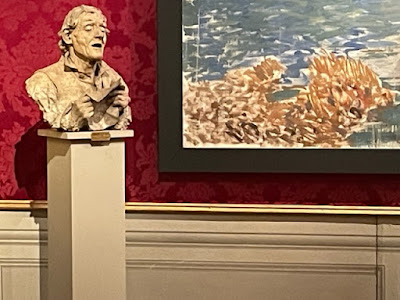I have long been fascinated with history. In fourth grade I remember taking every opportunity I could get to study the large American Heritage volume in the back of the classroom telling the history of the Civil War. I was an avid reader of biographies of famous people like Zebulon Pike, Paul Revere, Lewis and Clarke and others who shaped our past.There are many different ways to look at history. Some people see it as a series of great events, while others see it as the sum of the experiences of ordinary people. Some people see it as a linear progression, while others see it as a cyclical process. Some people see it as a story of progress, while others see it as a story of decline. (I can see these as simultaneous, which is interesting to me.)
Here are some of the different ways of looking at history according to Google's AI bot called Bard:
Great man theory: This is the view that history is made by great individuals, such as kings, queens, and presidents. It follows, naturally, that the educated class wrote books about these people as the movers and shakers of history.
Political history: This is the view that history is made by political events, such as wars, revolutions, and elections.
Economic history: This is the view that history is made by economic events, such as the invention of money (in ancient Mesopotamia) and the spread of the Roman Empire which produced safe roads resulting in widespread commerce. The Great Depression and, later, the collapse of the Soviet Union would be important chapters in this history.
Cultural history: This is the view that history is made by cultural events, such as the Renaissance and the Enlightenment.
Global history: This is the view that history is made by the interactions between different parts of the world. Historians who subscribe to this theory look at the world as a single interconnected unit, and that the history of any one part of the world cannot be understood without considering the history of other parts of the world.
Military history: This is the study of armed conflict in the history of humanity, and its impact on the societies, cultures and economies thereof, as well as the resulting changes to local and international relationships.
Digital history: This is the view that history is made by the use of digital technologies. Historians who subscribe to this theory believe that digital technologies are changing the way that history is written and studied.
Marxist view of history: History is a series of class struggles. In each historical epoch, there are two main classes: the ruling class and the oppressed class. The ruling class controls the means of production and the oppressed class does not. The ruling class exploits the oppressed class, and this exploitation leads to conflict between the two classes.
Religious History: By studying the origins of our world's religions and the manner in which they spread, we gain insights that can be applied to current events.
Social history: This is the view that history is made by ordinary people, and that it is important to study the lives of ordinary people in order to understand history. This focus has resulted in bringing to light multitudes of personal memoirs and diaries whose stories shed light on the perceptions and experiences of common people, humanity's herd.
These are just some of the different ways of looking at history, each way providing us with a different understanding of the past.
* * *
I re-arranged the Bard's list in order to end with a pitch for the book And There Shall Be Wars by Wilmer "Bud" Wagner and Lloyd Wagner. The book epitomizes this "Common Man" ordinary people perspective on history.
Bud was my father-in-law, the second civilian drafted into the WW2 at our local draft board here in Proctor. He carried a small pocket camera and kept a diary from beginning to end, from Camp Claiborne to Ireland to North Africa and the Italy Campaigns. His keen day by day observations have been amplified with a lifetime of research and reflection to provide readers with important insights through the eyes of a young soldier from rural Minnesota.
Bud served as a cook, machine gunner and company agent. He had the privilege of being on the first convoy to make its way across the Atlantic for the European theater. And the good fortune of having survived the duration of the war without becoming a casualty -- in North Africa and Italy, which included beachheads at Anzio and Salerno.
The book was a joint project involving the research skills and memoirs of WW II veteran Bud Wagner and his son Lloyd Wagner (Masters in Literature). Bud showed me his original diaries during a weekend visit when I was dating my wife Susie. He asked if anyone would be interested in them. I was floored by their contents as I leafed through the pages.
For years I encouraged him to amplify his diaries and make a book of them. A market gardener by trade, he used the long winters here to research and assemble the contents of this memoir. The results greatly exceeded my expectations and, with the able editing of his son, produced a fascinating manuscript. A large collection of photographs accompanies the text.
The book is titled And There Shall Be Wars. It is 536 pages with 178 original photos and illustrations.
Here is a letter from retired General John W. Vessey, former head of the Joint Chiefs of Staff, who received notice of his promotion to Captain while seated in Bud's jeep:
"Dear Bud, ... Thanks not only for the copy of the book, but also for putting those wartime notes into a permanent record. It is an important addition to all the "stuff" historians record. I couldn't put the book down once I got into it. It brought back a lot of memories reading about times, places, and people from 55+ years ago."
The book is currently out of print, though a couple copies are available at Amazon for $75. If interested, we have copies available for $20 + S&H. To purchase your copy, send a note expressing your interest to ennyman3@gmail.com
To learn more about And There Shall Be Wars visit: https://budwagneratsbw.blogspot.com/2012/11/and-there-shall-be-wars-contactorder.html






























